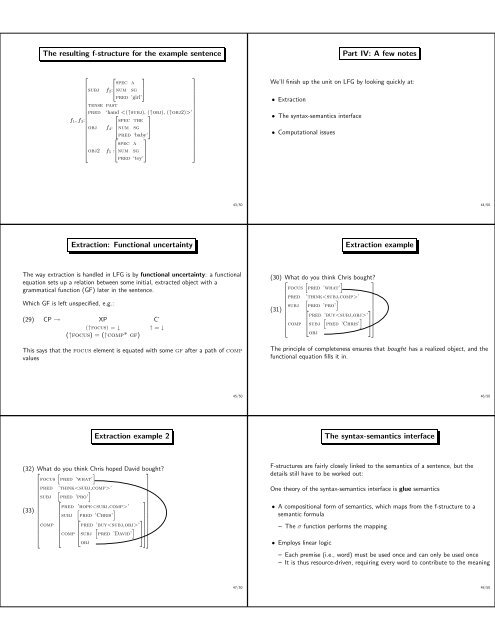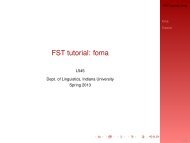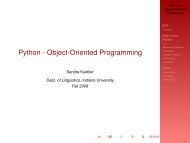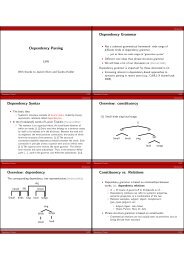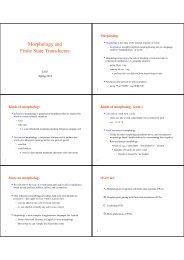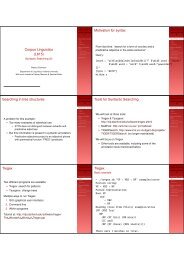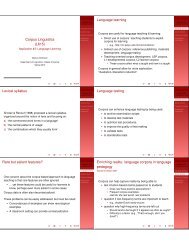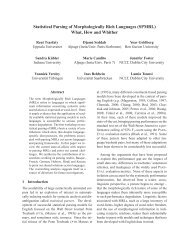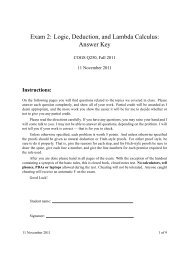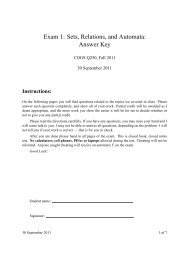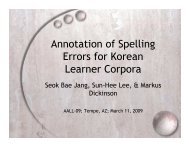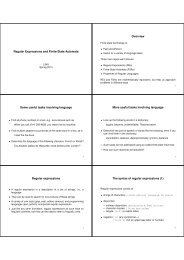Lexical-Functional Grammar (LFG) Motivation for LFG LFG in a ...
Lexical-Functional Grammar (LFG) Motivation for LFG LFG in a ...
Lexical-Functional Grammar (LFG) Motivation for LFG LFG in a ...
Create successful ePaper yourself
Turn your PDF publications into a flip-book with our unique Google optimized e-Paper software.
The result<strong>in</strong>g f-structure <strong>for</strong> the example sentence<br />
Part IV: A few notes<br />
2 2 3<br />
3<br />
spec a<br />
6 7<br />
subj f 2: 4num<br />
sg 5<br />
pred ’girl’<br />
tense past<br />
pred ‘hand ’<br />
2<br />
3<br />
f 1, f 3:<br />
spec the<br />
6<br />
7<br />
obj f 4: 4num<br />
sg 5<br />
pred ‘baby’<br />
2 3<br />
spec a<br />
6 6 7<br />
4obj2 f 5 : 4num<br />
sg<br />
7<br />
5<br />
5<br />
pred ‘toy’<br />
We’ll f<strong>in</strong>ish up the unit on <strong>LFG</strong> by look<strong>in</strong>g quickly at:<br />
• Extraction<br />
• The syntax-semantics <strong>in</strong>terface<br />
• Computational issues<br />
43/50<br />
44/50<br />
Extraction: <strong>Functional</strong> uncerta<strong>in</strong>ty<br />
Extraction example<br />
The way extraction is handled <strong>in</strong> <strong>LFG</strong> is by functional uncerta<strong>in</strong>ty: a functional<br />
equation sets up a relation between some <strong>in</strong>itial, extracted object with a<br />
grammatical function (GF) later <strong>in</strong> the sentence.<br />
Which GF is left unspecified, e.g.:<br />
(29) CP → XP<br />
(↑focus) = ↓<br />
(↑focus) = (↑comp* gf)<br />
C’<br />
↑ = ↓<br />
This says that the focus element is equated with some gf after a path of comp<br />
values<br />
(30) What do you th<strong>in</strong>k Chris bought?<br />
2 h<br />
i<br />
3<br />
focus pred ’what’<br />
pred ’th<strong>in</strong>k’<br />
h<br />
i<br />
subj pred ’pro’<br />
(31)<br />
2<br />
3<br />
pred ’buy’<br />
h<br />
i<br />
6comp<br />
6<br />
4 4<br />
subj pred ’Chris’<br />
7<br />
5<br />
obj<br />
The pr<strong>in</strong>ciple of completeness ensures that bought has a realized object, and the<br />
functional equation fills it <strong>in</strong>.<br />
45/50<br />
46/50<br />
Extraction example 2<br />
The syntax-semantics <strong>in</strong>terface<br />
(32) What do you th<strong>in</strong>k Chris hoped David bought?<br />
2 h<br />
i<br />
3<br />
focus pred ’what’<br />
pred ’th<strong>in</strong>k’<br />
h<br />
i<br />
subj pred ’pro’<br />
2<br />
3<br />
pred ’hope’<br />
(33)<br />
h<br />
i<br />
subj pred ’Chris’<br />
2<br />
3<br />
comp<br />
pred ’buy’<br />
h<br />
i<br />
6 6comp<br />
6<br />
4 4 4subj<br />
pred ’David’<br />
7<br />
5<br />
obj<br />
F-structures are fairly closely l<strong>in</strong>ked to the semantics of a sentence, but the<br />
details still have to be worked out:<br />
One theory of the syntax-semantics <strong>in</strong>terface is glue semantics<br />
• A compositional <strong>for</strong>m of semantics, which maps from the f-structure to a<br />
semantic <strong>for</strong>mula<br />
– The σ function per<strong>for</strong>ms the mapp<strong>in</strong>g<br />
• Employs l<strong>in</strong>ear logic<br />
– Each premise (i.e., word) must be used once and can only be used once<br />
– It is thus resource-driven, requir<strong>in</strong>g every word to contribute to the mean<strong>in</strong>g<br />
47/50<br />
48/50


